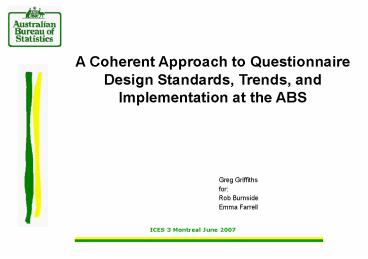Greg Griffiths - PowerPoint PPT Presentation
1 / 13
Title:
Greg Griffiths
Description:
A Coherent Approach to Questionnaire Design Standards, Trends, and ... Despatch and Collection Unit (DCU) Economic Standards and Classifications Section ... – PowerPoint PPT presentation
Number of Views:42
Avg rating:3.0/5.0
Title: Greg Griffiths
1
A Coherent Approach to Questionnaire Design
Standards, Trends, and Implementation at the ABS
Greg Griffiths for Rob Burnside Emma Farrell
ICES 3 Montreal June 2007
2
Overview
- How ABS enterprise questionnaire design standards
and guidelines are - implemented organizationally
- created and maintained
- scope and content of the standards
- trends - changes over time
- role of form design methodologists
- new modes and questionnaire structures and
- the Total Respondent experience
3
Big Picture
- Mandatory use of agreed standards for in-scope
instruments detailed in Corporate policy manual. - Common conventions, look and feel. Bringing about
use of best practice. - Organization arrangements give responsibility to
areas for different aspects of final forms - Form development process is supported by
- Standards manual containing guidelines and
examples available on the ABS intranet - Organizational structures incl survey-specific
meetings, an annual review of core questions and
- A forms image database with workflow/ sign-off
process Holds images and linked discussion for
interim, current and historical forms back to 1998
4
Responsibilities of areas involved
- Methodology Division Forms Consultancy Group
(FCG) - maintain and extend standards and guidelines
- understand mode effects and try to minimize
- RD into form design (all modes)
- Operational sections - manage survey process and
produce output - Economic Statistics Data Centre - includes a
specialised area constructing forms to standards
and coordinating testing - Conceptual sections - establish user needs
- Economic Standards Section - consistency of core
economic questions and classifications - National Accounts Branch - to ensure inputs for
Australian National Accounts
5
(No Transcript)
6
Scope and content
- Form standards cover
- format, structure and question wording
principles, common components - all modes - paper mail out, fax, CATI, Excel,
TDE/IVR - detailed specifications and examples for
different types of questions and forms - contact letters and emails
- Development and evaluation standards cover
- observational studies, usability testing,
cognitive testing ... - suitability of study design for answering
development questions.
7
Creation and maintenance of standards
- Relies on maintaining knowledge of ABS and
international theoretical and applied research
and experience - Maintenance and planned updating of standards
based on - Advice on development methods and approaches
- Emerging issues
- Involvement in field testing
- Organizing experiments to examine aspects of
design form length effects, scanning design,
effectiveness etc. - Urgency of development need
8
Trends 1 - Evolving role of ABS form design
methodologists (FCG) ctd
- Pre 2000 Policing layout standards
- 2000 Methodology standards established. Need to
examine broader measurement error recognized. - 2001 More modes and more development methods
- 2002/03 Total Approach Management and a wider
view - every interaction with the respondent is
significant - appropriate, consistent and
effective contact - 2007 Multimodal Data Collection project funded
- 2007 Move of household based collections into
same branch as FCG. New structure under
consideration.
9
Trends - 2 more modes and question types
- More modes
- structure, presentation and wording changes to
keep things the same conceptually - implies more, different testing and development
techniques - increase testing and creation cost
- form design increasingly intertwined with IT
capability and applications - More question structures
- Complex
- Subjective (i.e. non-economic)
- More like household questionnaire questions
10
Trends 3 - More development techniques
- More development techniques
- right technique to explore the right thing
- more use of cognitive and exploratory methods
- Post Enumeration Studies, behavior coding, card
sorting, interviewer debriefing - Expert review
- Classic usability testing for eform and CATI
- Classic experimental design where appropriate
11
Trends 4 - Total Approach Management
- Every interaction with a data provider is
important. The form is more than the form. - pre approach and covering letters,
- brochures and explanatory material,
- Telephone, fax and e-mail contacts
- The response experience is more than filling in
the form - Response enhancing techniques - social
influence theories - mode of choice, incentives .
12
Summary
Strong senior management recognition of the
importance of form design which is reflected in
organizational structure. Formal form
development process with defined roles and
sign-off. Corporate systems ensuring
communication of standards. Visibility of
deliberations decisions.
13
Summary
- A specialized group of methodologists exists
outside operational areas - Responsible for standards and development
methods - Involved in day-to-day form development as well
as RD into respondent related measurement
error - Centralization of methodology for all modes and
methods ensuring consistency - Maintains critical mass of expertise
- Maintains a strong commitment to research and
the communication of results / new developments
to operational areas































